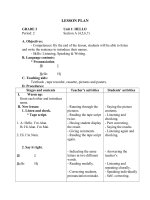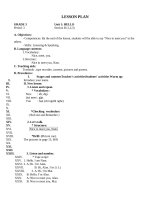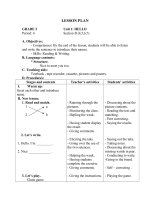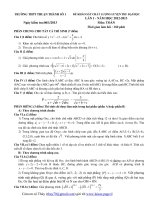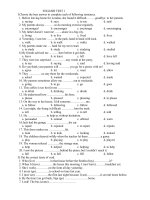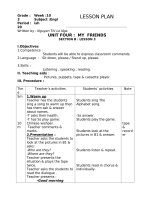Digital sat writing standard english convention 1 (1)
Bạn đang xem bản rút gọn của tài liệu. Xem và tải ngay bản đầy đủ của tài liệu tại đây (639.91 KB, 24 trang )
SAT Standard Conventions of English
Table of Contents
Part 1 Form, Structure, and Sense ............................................................................. 2
Subject Verb Agreement ........................................................................................................ 3
Pronoun Antecedent Agreement ......................................................................................... 5
Verb Form ................................................................................................................................... 8
Subject Modifier Placement.................................................................................................12
Plurals and Possessives.........................................................................................................15
How to form plurals and possessives ................................................................................15
Part 2 Boundaries ..........................................................................................................18
Linking Clauses .......................................................................................................................18
Supplements .............................................................................................................................21
Punctuation ..............................................................................................................................23
Sat Digital VietAccepted – Group Facebook “Luyện thi SAT Digital” & “Tự học New SAT 1600”
1
Part 1 Form, Structure, and Sense
Which Standard English conventions will be tested in form, structure, and sense questions?
Form, structure, and sense questions focus on these Standard English conventions:
•
•
•
•
•
Subject-verb agreement
Pronoun-antecedent agreement
Verb forms
Subject-modifier placement
Plural and possessive nouns
How to approach form, structure, and sense questions
Because each question will focus on a specific convention of Standard English, it's a great
first step to identify which grammar rule is being tested.
Here's one way to do that:
Step 1: Investigate the blank
• Read the text closely. What's missing that the blank needs to provide? A noun
phrase? A verb phrase? Something else?
• Compare the choices. What changes from choice to choice? Are verbs conjugated
differently? Are different pronouns used?
• Any patterns we can identify will be useful in the next step.
Step 2: Find the focus
• Based on our observations in the previous step, we should be able to identify which
Standard English convention(s) is being tested.
• For example, if the main difference between the choices is verb conjugation, we
should be focused on avoid errors in verb forms and in subject-verb agreement.
• If we can narrow our focus to just the convention(s) being tested, we'll have less to
think about. This can save us both time and brainpower.
Step 3: Eliminate the obvious errors
• Now it's time to take a closer look at the choices!
• Plug each choice into the blank, and read the passage through. Keeping in mind the
focus grammar rules, eliminate any choice that creates an obvious error.
• Once we eliminate choices that create errors, we'll be left with only one remaining
choice. We can select it with confidence!
Sat Digital VietAccepted – Group Facebook “Luyện thi SAT Digital” & “Tự học New SAT 1600”
2
Subject Verb Agreement
What is subject-verb agreement?
Subject-verb agreement is a convention of Standard English that requires a subject and
verb to agree in number.
Incorrect:
Apples is different from oranges.
Correct:
Apples are different from oranges.
"Is" is the singular present tense of the verb "to be". "Are" is the plural present tense of the
verb "to be".
Since "Apples " is a plural subject, it needs to be paired with the plural form of the verb.
This same logic must be applied to all subject-verb pairings.
Subject-verb agreement may be tested in one of the Form, structure, and sense questions
that you encounter on test day.
What can make subject-verb agreement errors difficult to spot?
When a verb follows directly after its subject, agreement is pretty easy to verify ("apples is"
vs "apples are"). However, when sentence structures become more complex, subject-verb
agreement errors can be much harder to spot.
Be extra cautious when you notice any of the following:
Extra words between the subject and verb
When additional words, especially other nouns, come between a subject and verb,
agreement errors are much easier to miss.
[Show example]
Incorrect:
•
Istanbul, the most populous of all European cities, were founded in the first
millennium BCE.
Correct:
•
Istanbul, the most populous of all European cities, was founded in the first
millennium BCE.
If you notice extra words or phrases, eliminate them from the sentence, and try reading the
subject straight into the verb.
Sat Digital VietAccepted – Group Facebook “Luyện thi SAT Digital” & “Tự học New SAT 1600”
3
Inverted sentences
Sometimes a subject will come after the verb. When this is the case, agreement errors are
trickier to identify.
[Show example]
Incorrect:
•
Separating the roads were a concrete median.
Correct:
•
Separating the roads was a concrete median.
If you notice a subject that comes after its verb, try flipping the sentence and reading the
subject straight in to the verb.
Top tips
Place subject and verb side-by-side
Any time you're not sure if a subject and verb agree, place them next to each other and see
how they sound together. This tip helps cut through complex sentence structures and tends
to make subject-verb agreement errors much more obvious.
Look out for prepositions
Prepositions like "with", "of", and "from" are often used to start phrases that describe the
subject of a sentence. These phrases can cause confusion, as the object of the prepositional
phrase ends up closer to the verb, and it's often a noun with a different number.
For example: "The sound of the trumpets was deafening."
The prepositional phrase "of the trumpets" may include a plural noun, but it describes the
singular subject "sound", so we need to use the singular verb "was".
Plurals and the letter 's'
If you're a fluent speaker of English, you'll often be able to pair plural nouns with plural
verbs based purely off of instinct and sound. But if that doesn't work, you need to be able to
identify singular and plural verbs.
With nouns, plurals are usually formed by adding an 's' to the end of the word:
elephant → elephants
With verbs, though, the pattern is exactly the opposite. Typically, we form a plural verb by
removing an 's':
The elephant runs.
The elephants run.
Sat Digital VietAccepted – Group Facebook “Luyện thi SAT Digital” & “Tự học New SAT 1600”
4
Pronoun Antecedent Agreement
Pronoun-antecedent agreement is a convention of Standard English that requires a
pronoun and antecedent to agree in person and number.
Incorrect:
Cranberries are both sour and bitter, so people rarely eat it unsweetened.
Correct:
Cranberries are both sour and bitter, so people rarely eat them unsweetened.
In both of these sentences, the bolded pronouns stand in for the noun "cranberries".
Since "cranberries" is a plural noun, it needs to be paired with the plural pronoun "they".
This same logic must be applied to all pronouns and their antecedents.
How to identify pronoun-antecedent agreement questions
When approaching form, structure, and sense questions, it's important to identify which
Standard English conventions are being tested.
You'll know to look for pronoun-antecedent agreement errors if
one choice uses a singular pronoun (like "it") while another choice uses a plural pronoun
(like "they")
a pronoun outside the blank refers to a noun contained within the choices
If you don't notice either of these features, then the question doesn't deal with pronounantecedent agreement.
Let's look at a pronoun-antecedent agreement question now:
It is hard to live in Antarctica. The cold, dry environment provides the continent’s soildwelling microbes few nutrients, little water, and almost no sunlight. In a 2017 study of
these organisms, microbiologist Belinda Ferrari reported that ______ able to survive on a
diet of atmospheric gases found in the soil.
Which choice completes the text so that it conforms to the conventions of Standard English?
A
it is
B
this is
C
either is
D
they are
Sat Digital VietAccepted – Group Facebook “Luyện thi SAT Digital” & “Tự học New SAT 1600”
5
What can make pronoun-antecedent agreement errors difficult to spot?
In simple sentences, the connection between a pronoun and its antecedent is often very
clear. However, as sentences become more complex, errors in pronoun-antecedent
agreement can be much more difficult to identify.
Be extra cautious when you notice any of the following:
Distance between pronoun and antecedent
The further apart a pronoun and its antecedent are in a sentence, the harder agreement
errors are to spot. Extra phrases and clauses interfere with our ability to work off instinct.
Errors in these cases are less likely to just "sound wrong". So, if you notice a pronoun way
out on its own, track down its antecedent and check for agreement. [Show me!]
Incorrect:
•
The record player largely fell out of style in the 1980s and 90s, but there has since
been a revival in their popularity.
Correct:
•
The record player largely fell out of style in the 1980s and 90s, but there has since
been a revival in its popularity.
In this compound sentence, the pronoun and its antecedent are in different independent
clauses, which makes the error harder to see.
Sat Digital VietAccepted – Group Facebook “Luyện thi SAT Digital” & “Tự học New SAT 1600”
6
But once we identify the antecedent as the singular noun phrase "the record player", we
know to use the singular pronoun "it".
Multiple nouns before the pronoun
When multiple nouns appear before a pronoun in a sentence, identifying the correct
antecedent can be tricky. Errors in pronoun-antecedent agreement will be difficult to
identify in these cases, especially if some of the nouns are plural and others are singular.
When you notice multiple nouns before the pronoun, take the time to identify the most
logical antecedent. [Show me!]
Incorrect:
•
The cougar, the largest of all North American cats, has lost most of theirrange in
the eastern United States.
Correct:
•
The cougar, the largest of all North American cats, has lost most of itsrange in the
eastern United States.
Explanation: Even though “cats” is a plural noun close to the pronoun, it isn’t the logical
antecedent of the pronoun. The actual antecedent, “cougar”, is a singular noun and
requires the singular "it".
Pronoun before the antecedent
"Antecedent" literally means what comes before, but sometimes this relationship gets
flipped. And when a pronoun becomes before its antecedent, we're less likely to notice an
agreement error.
If you see a pronoun towards the beginning of the text, track down the noun it refers to and
double check for agreement. [Show me!]
Incorrect:
•
While it may not be widely associated with long life, ocean clams have been known
to live for over 500 years.
Correct:
•
While they may not be widely associated with long life, ocean clams have been
known to live for over 500 years.
Sat Digital VietAccepted – Group Facebook “Luyện thi SAT Digital” & “Tự học New SAT 1600”
7
Since we read the pronoun before we know whether its antecedent is plural or singular, this
error can be hard to identify. But once we notice that our antecedent is the plural noun
"clams", we know to use the plural pronoun "they".
Verb Form
Verbs can take many different forms. They can have different tenses and aspects. They can
also be finite or non-finite. There are modal verbs, auxiliary verbs, and a dozen other
possible categories.
The grammar science behind these different verb forms is complex. Luckily, you don't need
to actually do any of this tricky classification to succeed on the SAT.
You've already been exposed to all these different verb forms in your everyday studies, and
you likely use them all the time without thinking about it. If you rely on your instincts and
familiarity with Standard English, choosing the correct verb form should come pretty
naturally.
Incorrect:
Yesterday, I am running to the lake.
Correct:
Yesterday, I ran to the lake.
The verb phrase "am running" is in the present tense and the progressive aspect. However,
the sentence tells us the action happened "yesterday", so we should use the past tense and
the simple aspect: "ran".
[Show me more tenses and aspects]
How to identify verb form questions
When approaching form, structure, and sense questions, it's important to identify which
Standard English conventions are being tested.
Sat Digital VietAccepted – Group Facebook “Luyện thi SAT Digital” & “Tự học New SAT 1600”
8
You'll know to look for verb form errors if different choices use different verb tenses
(past/present/future) or some choices add or remove helping verbs
If you don't see one or both of these differences among the choices, then the question doesn't
deal with verb forms.
Let's look at a verb forms question now:
While many spiders use webs to catch their food, others capture prey using hunting or
burrowing techniques. Spiders from the family Ctenizidae, often called trapdoor spiders,
______ their burrows with doors, using their silk for hinges.
Which choice completes the text so that it conforms to the conventions of Standard English?
A
cover
B
are covering
C
will have covered
D
had covered
Sat Digital VietAccepted – Group Facebook “Luyện thi SAT Digital” & “Tự học New SAT 1600”
9
What can make verb form errors difficult to spot?
Complex sentence structures
Verb form errors in simple sentences tend to be pretty obvious. But as sentences become
more complex, it becomes easier to miss those little context clues that tell us when and how
the verb is taking place.
Incorrect:
•
Author and anthropologist Zora Neale Hurston, whose active period spanned from
1925 to 1950, famously writes many different types of literary works, including
novels, plays, and essays.
Correct:
•
Author and anthropologist Zora Neale Hurston, whose active period spanned from
1925 to 1950, famously wrote many different types of literary works, including
novels, plays, and essays.
Missing helping verbs
Only simple verbs can function without help.
Incorrect:
•
Phosphorous, an impurity which can cause steel to be too brittle, commonly
found in raw iron ore.
Correct:
•
Phosphorous, an impurity which can cause steel to be too brittle, is commonly
found in raw iron ore.
When a helping verb is missing from any other type of verb phrase, that verb phrase can no
longer function as the main verb of the sentence. This often creates a sentence fragment
error.
When we're reading quickly, our brains have a tendency to fill in these missing verbs,
which can cause us to overlook the error. Take your time as you read and make sure that
each verb phrase has everything it needs to function.
Sat Digital VietAccepted – Group Facebook “Luyện thi SAT Digital” & “Tự học New SAT 1600”
10
Top tips
Conjugate in context
To determine if an action happens in the past, present, or future, we'll need to rely upon
context clues in the sentence. The same goes for whether an action is completed or ongoing.
Common context clues include dates, times, and other conjugated verbs.
Match other verbs
If you're not sure how to conjugate a verb, match the tense of other verbs in the same
sentence or paragraph. Verb tense usually stays consistent unless some shift in time occurs
within the passage.
Simple present tense for general facts
General statements of fact use simple present tense (e.g., "the sky is blue"). So, if there are
no context clues that suggest a shift in tense or aspect, simple present tense is likely the
best way to go.
Sat Digital VietAccepted – Group Facebook “Luyện thi SAT Digital” & “Tự học New SAT 1600”
11
Subject Modifier Placement
Subject-modifier placement refers to a convention of Standard English that requires a
modifier and its subject to be next to one another.
Incorrect:
Consumed in the form of sugars and starches, the human body uses carbohydrates as its
primary source of energy.
In this version of the sentence, the modifying phrase "consumed in the form of sugars and
starches" is next to "the human body". However, the sentence isn't meant to suggest that "the
human body is consumed in the form of sugars and starches".
This is a modifier placement error.
Correct:
Consumed in the form of sugars and starches, carbohydrates serve as the primary source of
energy for the human body.
In this version of the sentence, the modifying phrase "consumed in the form of sugars and
starches" is logically followed by the noun it describes: "carbohydrates".
How to identify subject-modifier placement questions
When approaching form, structure, and sense questions, it's important to identify which
Standard English conventions are being tested.
You may want to look for subject-modifier placement errors if
• the blank is longer than a few words
• the choices rearrange words or phrases into different orders
If you don't see one or both of these features, then the question likely doesn't deal with
subject-modifier placement.
Let's look at a subject-modifier placement question now:
Sat Digital VietAccepted – Group Facebook “Luyện thi SAT Digital” & “Tự học New SAT 1600”
12
SUBJECT-MODIFIER PLACEMENT EXAMPLE
Rabinal Achí is a precolonial Maya dance drama performed annually in Rabinal, a town in
the Guatemalan highlands. Based on events that occurred when Rabinal was a city-state
ruled by a king, ______ had once been an ally of the king but was later captured while
leading an invading force against him.
Which choice completes the text so that it conforms to the conventions of Standard English?
(Choice A)
A
Rabinal Achí tells the story of K’iche’ Achí, a military leader who
(Choice B)
B
K’iche’ Achí, the military leader in the story of Rabinal Achí,
(Choice C)
C
there was a military leader, K’iche’ Achí, who in Rabinal Achí
(Choice D)
D
the military leader whose story is told in Rabinal Achí, K’iche’ Achí,
Top tips
Double-check introductory modifiers
Sat Digital VietAccepted – Group Facebook “Luyện thi SAT Digital” & “Tự học New SAT 1600”
13
When modifying phrases come at the beginning of a sentence, our brains will often do the
work of connecting the modifier to whichever noun it logically describes. But these
modifying phrases don't apply to the whole sentence: they still need to be placed right next
to their subjects.
Any time you see a blank come after an introductory modifying phrase, double check the
noun that follows to be sure it makes sense alongside the modifier.
Notice where the blank shows up in our example question:
Based on events that occurred when Rabinal was a city-state ruled by a king, ______
The whole paragraph is focused on the dance drama Rabinal Achí, so it's easy to connect
that subject to this introductory modifier. However, we still need to make sure that the noun
phrase following the modifier makes sense in the context of that particular sentence.
Only choice A correctly places Rabinal Achí in that spot.
Beware possessive nouns
When a noun phrase starts with a possessive noun, it can make modifier placement extra
confusing. Remember that possessive nouns really function as adjectives: the noun that
follows the possessive is the actual focus of the noun phrase. That's the noun the modifier
needs to describe.
Incorrect:
•
Exhausted from running home in the rain, Erin's jacket was soaking wet.
Correct:
•
Exhausted from running home in the rain, Erin pulled off her soaking wet jacket.
In the first version of this sentence, the modifier illogically applies to the noun "jacket". It
doesn't make sense to say that "Erin's jacket was exhausted". It's Erin that's exhausted.
We can fix this error in modifier placement by adjusting the second half of the sentence so
that "Erin" is the noun that the modifier logically describes.
Sat Digital VietAccepted – Group Facebook “Luyện thi SAT Digital” & “Tự học New SAT 1600”
14
Plurals and Possessives
Plurals are nouns and pronouns that refer to more than one thing.
Possessives are nouns and pronouns that show possession.
There are similarities and differences in how plurals and possessives are formed that can
cause confusion. In particular, confusion can arise over when to use or not use apostrophes.
Incorrect:
One cannot overstate the importance of bee's to the pollination of Michigans blueberry crop.
•
"bee's"
This noun should be plural, not possessive, so we shouldn't use an apostrophe.
•
"Michigans"
This noun should be possessive, not plural, so we should place an apostrophe before the "s".
Correct:
One cannot overstate the importance of bees to the pollination of Michigan's blueberry crop.
This version of the sentence correctly forms the plural noun "bees" and the possessive noun
"Michigan's".
How to form plurals and possessives
To succeed on questions about plural and possessive nouns, you'll need to know the rules
for using apostrophes in the following cases:
•
Plural nouns
[Explain] Plural nouns do not require an apostrophe.
Example: The plants in the greenhouse are thriving.
•
Singular possessive nouns
[Explain] Singular possessive nouns require an apostrophe followed by an "s".
Example: The company's most popular products include shampoo and moisturizer.
Note: This rule applies even if the singular noun already ends in "s" (e.g.,
the rhinoceros's horn)
Sat Digital VietAccepted – Group Facebook “Luyện thi SAT Digital” & “Tự học New SAT 1600”
15
•
Plural possessive nouns
[Explain] Plural possessive nouns that end in "s" require an apostrophe after the "s".
Example: On many superhero teams, the heroes' costumes are each a different color.
Note: If a plural noun doesn't end in "s", then an "s" should be added after the apostrophe
(e.g., the men's swim team).
•
Pronouns
[Explain] never use apostrophes. His and hers don't use apostrophes. Yours, ours, and
theirs are in the same category.
Example: His favorite food is the same as hers.
How to identify questions about plurals and possessives
When we approach form, structure, and sense questions, it's important to identify which
Standard English conventions are being tested.
Make sure to look for errors with genitives and plurals if
• the choices add or remove apostrophes
• the choices change the placement of apostrophes
If you don't see one or both of these features, then the question likely doesn't deal with
plurals and possessives.
Let's look at a plurals and possessives question now:
Slam poet Elizabeth Acevedo’s debut novel The Poet X, winner of the 2018 National Book
Award for Young People’s Literature, is composed of ______ protagonist, fifteen-year-old
Xiomara Batista.
Which choice completes the text so that it conforms to the conventions of Standard English?
A
poem’s putatively written by the novel’s
B
poem’s putatively written by the novels’
C
poems putatively written by the novels’
D
poems putatively written by the novel’s
Sat Digital VietAccepted – Group Facebook “Luyện thi SAT Digital” & “Tự học New SAT 1600”
16
We should quickly notice that the choices are quite similar: the only difference is the
placement of apostrophes. This is a strong indication that the question will require us to
avoid an error in plurals and possessives.
There are two words up for debate in the choices:
•
"poems"
•
"novels"
Let's take them on one at a time.
"Poems":
•
Based on the sentence, we're discussing more than one poem, so "poems" must be
plural.
•
What comes after "poems" doesn't belong to the poems, so "poems" should not be
possessive.
Since plural, non-possessive nouns don't require an apostrophe, the noun used should
be "poems".
"Novels":
•
Based on the sentence, we're discussion only one novel, so "novels" should not be
plural.
•
What comes after "novels" (the protagonist) does belong to the novel, so "novels"
must be possessive.
Since singular possessive nouns require an apostrophe before the "s", the noun used should
be "novel's".
Only choice D uses both the nouns "poems" and "novel's". Choice D is the answer.
Sat Digital VietAccepted – Group Facebook “Luyện thi SAT Digital” & “Tự học New SAT 1600”
17
Part 2 Boundaries
Linking Clauses
A clause is a series of words that contains a subject and a conjugated verb. There are two
main types of clauses:
• An independent clause can stand on its own as a complete sentence.
• A dependent clause must be linked to an independent clause.
The SAT focuses on how clauses can be linked together (or kept apart). These conventions
may be tested in Boundaries questions that you encounter on test day.
Linking clauses
There are several ways to link clauses. The SAT focuses on end of sentence punctuation,
coordination, subordination, and semicolons.
Let's look at each in turn:
End of sentence punctuation
Using end punctuation (like a period or question mark) is the simplest way to separate
clauses. You should be very familiar with using end punctuation in your own writing.
There are only two rules for end punctuation:
The punctuation mark must match the function of the sentence it follows. [Show me]
Incorrect:
•
I've often wondered how are birds able to navigate?
Correct:
•
I've often wondered how birds are able to navigate.
This sentence is a statement: "I've often wondered."
The incorrect version confuses the purpose of the sentence, phrasing the second half like a
question and ending things with a question mark. The correct version appropriately
phrases the sentence to function as a statement, ending things with a period.
End punctuation can only be used to separate two independent clauses. [Show me]
Incorrect:
Sat Digital VietAccepted – Group Facebook “Luyện thi SAT Digital” & “Tự học New SAT 1600”
18
•
After sliced bread was introduced to the market in 1928. It quickly eclipsed the
popularity of unsliced bread.
Correct:
•
After sliced bread was introduced to the market in 1928, it quickly eclipsed the
popularity of unsliced bread.
The first clause in the sentence ("After . . . 1928") is a dependent clause. It can't stand on its
own as a sentence, so using a period creates an error.
Coordination
Coordination involves the linking of two independent clauses within a single sentence. To
coordinate independent clauses, we must use two things:
a comma (,)
a coordinating conjunction
The only coordinating conjunctions in English are known as the FANBOYS (for, and, nor,
but, or, yet, so).
Incorrect:
•
Astronomical seasons are based on the position of the sun, meteorological seasons
are based on temperature and weather.
•
Astronomical seasons are based on the position of the sun butmeteorological
seasons are based on temperature and weather.
The first version of the sentence fails to use a coordinating conjunction, creating a comma
splice error. The second version of thet sentence fails to use a comma, creating a run-on
sentence error.
Correct:
•
Astronomical seasons are based on the position of the sun, butmeteorological
seasons are based on temperature and weather.
Sat Digital VietAccepted – Group Facebook “Luyện thi SAT Digital” & “Tự học New SAT 1600”
19
Subordination
Subordination involves linking two clauses by making one of the clauses dependent. To
subordinate an independent clause, we must use two things:
a subordinating conjunction
a comma (,)*
Subordinating conjunctions are words that turn an independent clause into a dependent
clause. There are many subordinating conjunctions, but some examples include although,
since, because, while, when, and after.
Incorrect:
•
Broccoli, kale, and kohlrabi may seem like very different vegetables, theyare all
cultivars of the same plant species.
This version of the sentence links two independent clauses using only a comma, creating
a comma splice error.
Correct:
•
Though broccoli, kale, and kohlrabi may seem like very different vegetables,
they are all cultivars of the same plant species.
By adding the subordinating conjunction "though", the first clause is made dependent. It
can then be linked to the second clause with just a comma.
*Note: Some subordinating conjunctions can link clauses without a comma, but only if the
dependent clause comes second.
Semicolons
Semicolons can be used to link two independent clauses without any conjunction.
Incorrect:
•
The Green Zebra tomato ripens without turning red; which makes it difficult to
know when one is ready to eat.
•
The Green Zebra tomato ripens without turning red; and this makes it difficult to
know when one is ready to eat.
The first version of the sentence uses a semicolon to connect an independent clause to
a dependent clause, which creates a punctuation error. The second version uses both a
semicolon and a conjunction, which is unnecessary and unconventional.
Sat Digital VietAccepted – Group Facebook “Luyện thi SAT Digital” & “Tự học New SAT 1600”
20




